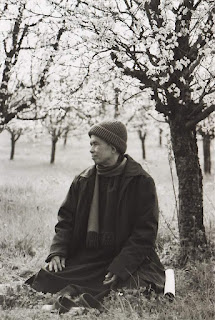The Teachings of Thich Nhat Hanh.
'Breathing in, I know this is my in-breath. Breathing out, I know this is my out-breath.
💮'The sixteen exercises proposed by the Buddha on mindful breathing.'
“It is like this, bhikkhus: the practitioner goes into the forest or to the foot of a tree, or to any deserted place, sits stably in the lotus position, holding his or her body quite straight, and practices like this:
💮Breathing in a long breath, I know I am breathing in a long breath.
Breathing out a long breath, I know I am breathing out a long breath.
💮Breathing in a short breath, I know I am breathing in a short breath.
Breathing out a short breath, I know I am breathing out a short breath.
💮Breathing in, I am aware of my whole body. Breathing out, I am aware of my whole body.
💮Breathing in, I calm my whole body.
Breathing out, I calm my whole body.
💮Breathing in, I feel joyful.
Breathing out, I feel joyful.
💮Breathing in, I feel happy. Breathing out, I feel happy.
💮Breathing in, I am aware of my mental formations. Breathing out, I am aware of my mental formations.
💮Breathing in, I calm my mental formations. Breathing out, I calm my mental formations.
💮Breathing in, I am aware of my mind. Breathing out, I am aware of my mind.
💮Breathing in, I make my mind happy. Breathing out, I make my mind happy.
💮Breathing in, I concentrate my mind. Breathing out, I concentrate my mind.
💮Breathing in, I liberate my mind.
Breathing out, I liberate my mind.
💮Breathing in, I observe the impermanent nature of all dharmas.
Breathing out, I observe the impermanent nature of all dharmas.
💮Breathing in, I observe the disappearance of desire. Breathing out, I observe the disappearance of desire.
💮Breathing in, I observe the no-birth, no-death nature of all phenomena. Breathing out, I observe the no-birth, no-death nature of all phenomena.
💮Breathing in, I observe letting go.
Breathing out, I observe letting go.’
"There is a little difference between joy and happiness. In joy there is still some excitement. But in happiness you are calmer.
In the Buddhist literature there is the image of someone very thirsty walking in the desert, and suddenly he sees an oasis, trees encircling a pond. So he experiences joy. He has not drunk the water yet. He is still thirsty, but he is joyful because he needs only to walk a few more minutes to arrive at the pond. That is joy.
There is some excitement and hope in him.
And when that traveler comes to the oasis, kneels down and cups his hands, and drinks the water, he feels the happiness of drinking water, quenching his thirst. That is happiness, very fulfilling.
In Buddhism the world is considered the object of mind. Our mind, our consciousness, our perception, may be described as having two components: the knower and the knowable. In Buddhism when you write the word “Dharma” with a capital letter, it means the teaching, the law. When you write the word “dharma” with a small letter, it means the object of your mind.
Most of us get caught in notions when we learn Buddhism. We don’t know how to make skillful use of these teachings in order to bring about insight. We have to practice. While sitting, walking, reading, drinking, we are concentrating... Concentration means to keep awareness alive, moment after moment, to maintain it for a long time. Only concentration can bring insight and liberate you."
❤Thich Nhat Hanh
Excerpts from 'Discourse on the Full Awareness of Breathing' and Dharma Talk, August 16, 2009
Image: Thay in the orchard at Plum Village

No comments:
Post a Comment